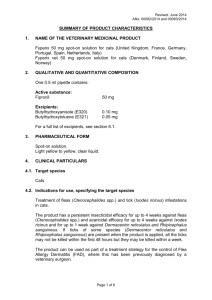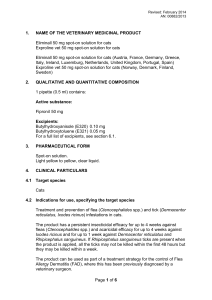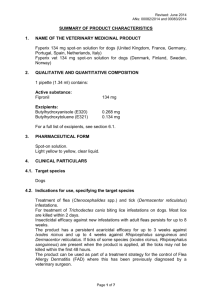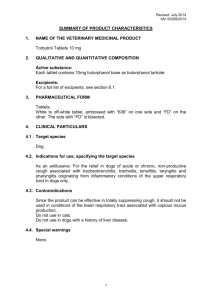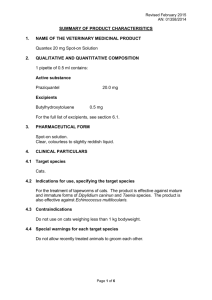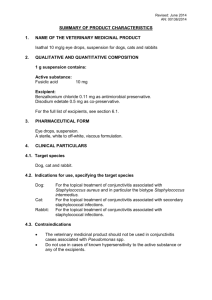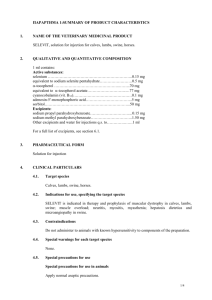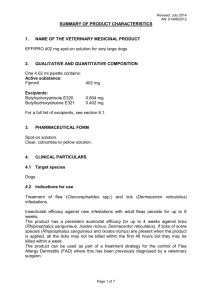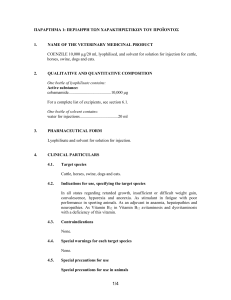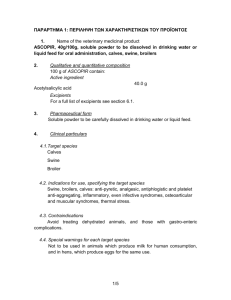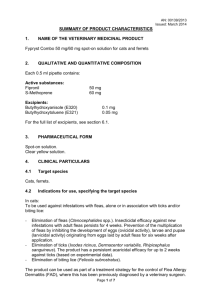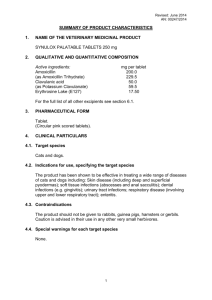Vm - Veterinary Medicines Directorate
advertisement
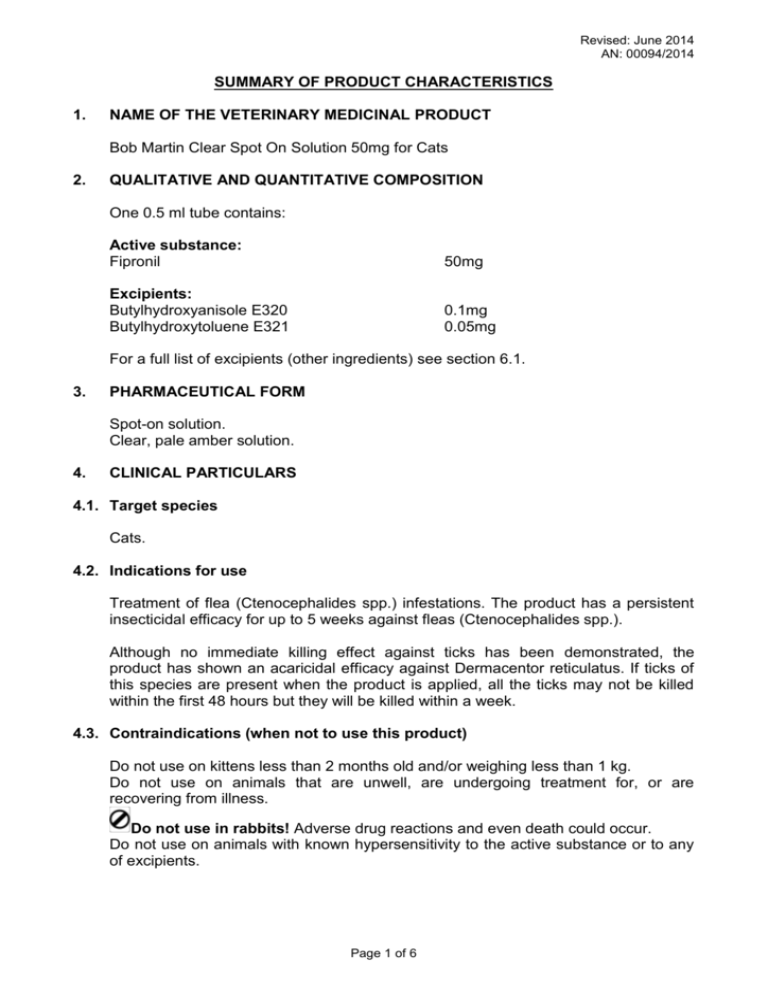
Revised: June 2014 AN: 00094/2014 SUMMARY OF PRODUCT CHARACTERISTICS 1. NAME OF THE VETERINARY MEDICINAL PRODUCT Bob Martin Clear Spot On Solution 50mg for Cats 2. QUALITATIVE AND QUANTITATIVE COMPOSITION One 0.5 ml tube contains: Active substance: Fipronil 50mg Excipients: Butylhydroxyanisole E320 Butylhydroxytoluene E321 0.1mg 0.05mg For a full list of excipients (other ingredients) see section 6.1. 3. PHARMACEUTICAL FORM Spot-on solution. Clear, pale amber solution. 4. CLINICAL PARTICULARS 4.1. Target species Cats. 4.2. Indications for use Treatment of flea (Ctenocephalides spp.) infestations. The product has a persistent insecticidal efficacy for up to 5 weeks against fleas (Ctenocephalides spp.). Although no immediate killing effect against ticks has been demonstrated, the product has shown an acaricidal efficacy against Dermacentor reticulatus. If ticks of this species are present when the product is applied, all the ticks may not be killed within the first 48 hours but they will be killed within a week. 4.3. Contraindications (when not to use this product) Do not use on kittens less than 2 months old and/or weighing less than 1 kg. Do not use on animals that are unwell, are undergoing treatment for, or are recovering from illness. Do not use in rabbits! Adverse drug reactions and even death could occur. Do not use on animals with known hypersensitivity to the active substance or to any of excipients. Page 1 of 6 Revised: June 2014 AN: 00094/2014 4.4. Special warnings for each target species Fleas from pets often infest the animal's basket, bedding and regular resting areas such as carpets and soft furnishings which should be treated, in case of massive infestation and at the beginning of the control measures, with a suitable insecticide and vacuumed regularly. Avoid frequent swimming or shampooing the animal because the maintenance of effectiveness of the product in these cases has not been tested. For optimum control of flea problems in a multi-pet household, all dogs and cats in the household should be treated with a suitable insecticide. 4.5. Special precautions for use i) Special precautions for use in animals Avoid contact with the animal’s eyes. In the case of accidental eye contact, immediately and thoroughly flush the eyes with water. Do not apply the product on wounds or damaged skin. It is important to make sure that the product is applied to an area where the animal cannot lick it off, and to make sure that animals do not lick each other following treatment. The safety of the product has not been investigated in studies where overdose or repeated dosing were used due to the well-known safety profile of the active substance and the other ingredients. ii) Special precautions to be taken by the person administering the veterinary medicinal product to animals This product can cause mucous membrane and eye irritation. Therefore, contact between the product and the mouth or eyes should be avoided. In the case of accidental eye contact, immediately and thoroughly flush the eyes with water. If eye irritation persists seek medical advice and show the package leaflet or the label to the physician. Avoid contents coming into contact with the fingers. If this occurs, wash hands with soap and water. Wash hands after use. Do not smoke, drink or eat during application. Animals or people with a known hypersensitivity to fipronil or any of the other ingredients should avoid contact with the product. Treated animals should not be handled until the application site is dry, and children should not be allowed to play with treated animals until the application site is dry. It is therefore recommended that animals are not treated during the day, but should be treated during the early evening, and that recently treated animals should not be allowed to sleep with owners, especially children. iii) Other precautions The product may have adverse effects on painted, varnished or other household surfaces or furnishings. Page 2 of 6 Revised: June 2014 AN: 00094/2014 4.6. Adverse reactions (frequency and seriousness) If licking occurs, a brief period of excessive salivation / drooling may be observed due mainly to the solvents in the product. Among the extremely rare suspected adverse reactions, short duration skin reactions at the application site (scaly skin, hair loss at the application site, skin irritation, itching and reddening) and general skin irritation or hair loss have been reported after use. Rarely, excessive drooling / salivation, and reversible nervous signs (e.g. excitability, depression) or vomiting have been observed after use. 4.7. Use during pregnancy and lactation Not recommended for use in pregnant dogs/cats or where the dog/cat is providing milk for puppies/kittens. If in doubt, seek the advice of your usual veterinary surgeon. 4.8. Interaction with other medicinal products and other forms of interaction None known. Page 3 of 6 Revised: June 2014 AN: 00094/2014 4.9. Amounts to be administered and administration route Route of administration and dosage: External use only. Administer by topical application to the skin 1 tube of 0.5 ml per animal. Remove the tube from the blister packaging. Hold the tube in an upright position and snap off the top section of the cap, thereby opening the tube. Part the pet’s coat until the skin is visible. Place the tip of the tube directly against the bared skin and squeeze gently. Empty approximately half the contents at two points along the cat’s back, preferably at the base of the head and between the shoulder blades. Squeeze the tube several times to ensure dosing is complete. Avoid applying the solution onto the fur and do not rub into the skin. Application of the solution as directed minimises the possibility that the animal will lick the solution off. Care should be taken to avoid excessive wetting of the hair with the product since this will cause a sticky appearance of hairs at the treatment spot. However, should this occur, it will usually disappear within 24-48 hours post application. There is little evidence available from studies with this product in cats; however, from studies in dogs, crystals may be seen on the hair and slight scaling may occur within 24-48 hours after application. Treatment schedule: The minimum interval between two treatments is 4 weeks. In some cases longer intervals between treatments may be appropriate. For advice speak to your veterinary surgeon. 4.10. Overdose (symptoms, emergency procedures, antidotes), if necessary The risk of adverse effects (see section 4.6) with the veterinary medicinal product when administered to the skin is very low. The risk may increase in cases of overdose, so animals should always be treated with the correct product according to species and bodyweight. Be certain to select and use the correct product for your pet. 4.11. Withdrawal period Not applicable. Page 4 of 6 Revised: June 2014 AN: 00094/2014 5. PHARMACOLOGICAL PROPERTIES Pharmacotherapeutic group: Ectoparasiticides for topical use. ATCVet Code: QP53AX15 5.1. Pharmacodynamic properties Fipronil is an insecticide and acaricide belonging to the phenylpyrazole family. It acts by inhibiting the GABA complex, binding to the chloride channel and thereby blocking pre- and post-synaptic transfer of chloride ions across cell membranes. This results in uncontrolled activity of the central nervous system and death of insects or acarids. Fipronil exhibits an insecticidal and acaricidal activity against fleas (Ctenocephalides spp) and acaricidal activity against ticks (Dermacentor reticulatus) in the cat. Fleas will be killed within 24 h. Ticks will usually be killed within two weeks after contact with fipronil. 5.2. Pharmacokinetic particulars In vitro, fipronil is mainly metabolised with subcellular liver fractions to its sulfone derivative. However, this may be of limited relevance ‘in vivo’ as fipronil is poorly absorbed in the cat. The concentrations of fipronil on the hair decrease with time. 6. PHARMACEUTICAL PARTICULARS 6.1. List of excipients (other ingredients) Butylhydroxyanisole E320 Butylhydroxytoluene E321 Propylene glycol Benzyl alcohol Diethylene glycol monoethyl ether 6.2. Incompatibilities None known. 6.3. Shelf life Shelf-life of the veterinary medicinal product as packaged for sale: 2 years. 6.4. Special precautions for storage Store below 25C, in a dry place in the original packaging. Page 5 of 6 Revised: June 2014 AN: 00094/2014 6.5. Nature and composition of immediate packaging White opaque or pink or green translucent polypropylene single-dose tubes containing an extractable volume of 0.5 ml packaged in a clear PVC blister closed by heat sealing with aluminium foil and placed in a carton box or blister card. Blister cards or boxes of 1, 2, 3, 4, 5 or 6 tubes. Not all pack sizes may be marketed. 6.6. Special precautions for the disposal of unused veterinary medicinal product or waste materials derived from the use of such products Any unused veterinary medicinal product or waste materials derived from such veterinary medicinal products should be disposed of in accordance with local requirements. Fipronil may adversely affect aquatic organisms. Do not contaminate ponds, waterways or ditches with the product or empty container. 7. MARKETING AUTHORISATION HOLDER Bob Martin (UK) Ltd Wemberham Lane Yatton North Somerset BS49 4BS 8. MARKETING AUTHORISATION NUMBER Vm: 00715/4118 9. DATE OF FIRST AUTHORISATION Date: 27 May 2011 10. DATE OF REVISION OF THE TEXT Date: June 2014 26 June 2014 Page 6 of 6
